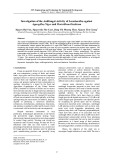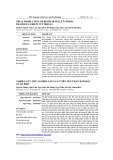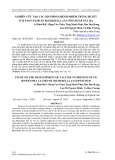
Vietnam Journal
of Agricultural
Sciences
ISSN 2588-1299
VJAS 2023; 6(4): 1946-1957
https://doi.org/10.31817/vjas.2023.6.4.05
1946
Vietnam Journal of Agricultural Sciences
Received: December 30,
2022
Accepted: December 29, 2023
Correspondence to
tvhai@vnua.edu.vn
Comparative Analysis of an Integral
Component of Bacterial Cell Division from
the Lactococcus and Bacillus Genera
Tong Van Hai1, Vu Ngoc Lan 2, Pham Thu Ha1, Le Thi Van1,
Tran Thi Hong Hanh1, Bui Thi Thu Huong1, Nguyen Hai
Phuong3, Ha Thi Quyen4 & Ha Duc Chu4
1Faculty of Biotechnology, Vietnam National University of Agriculture, Hanoi 131000,
Vietnam
2Faculty of Agronomy, Vietnam National University of Agriculture, Hanoi 131000,
Vietnam
3Department of Biochemistry, National Hospital of Obstetrics and Gynecology, Hanoi
111670, Vietnam
4Faculty of Agricultural Technology, University of Engineering and Technology, Vietnam
National University of Hanoi, Hanoi 113100, Vietnam
Abstract
FtsZ proteins have been well-characterized to play a crucial role in
cell division. Unfortunately, data are scarce on FtsZ proteins in the
Lactococcus and Bacillus genera. The objective of this study was to
analyze the features of FtsZ proteins in the Bacillus and Lactococcus
genus groups. By exploring the available genomes, we identified and
characterized FtsZ proteins in 19 Bacillus and 22 Lactococcus
species. The sizes and weights of the FtsZ proteins ranged from 376
to 410 aa residues and 39.53 to 44.15 kDa in the Bacillus genus,
respectively, and from 387 to 430 aa residues and 41.14 to 45.11 kDa
in the Lactococcus genus, respectively. All the FtsZ proteins in the
Bacillus and Lactococcus species were acidic and globular, and
localized in the cytoplasm. Next, 3D modeling and multiple
alignments were performed. We realized that the FtsZ proteins in the
Bacillus and Lactococcus species exhibited five specific regions.
Taken together, our study could provide a general background for
further functional characterization of the FtsZ proteins in Bacillus
and Lactococcus species.
Keywords
Lactococcus, Bacillus, FtsZ, conserved domain, protein
Introduction
Cell division is a crucial process for living organisms. Principally,
cell division in bacteria is orchestrated by a divisome. In this step, FtsZ,
a polymer-forming guanosine-5′-triphosphatease (GTPase), drives
bacterial cell division (de Boer et al., 1992; Löwe and Amos, 1998).

Tong Van Hai et al. (2023)
https://vjas.vnua.edu.vn/
1947
Particularly, FtsZ proteins play the role as
the pacemaker of the formation of the divisome
and the cytokinesis process (Margolin, 2005) as
it assembles into proto-filaments to construct a
ring-like template (McQuillen and Xiao, 2020).
The formation of this ring initiates and facilitates
cellular division, enabling a single parent cell to
give rise to two offspring cells, while the
divisome plays a pivotal role in the constriction
of the cell envelope and the generation of new
cell wall segments at the division site. FtsZ also
has an extended role beyond cellular division
where it contributes to determining cell
morphology and establishing polarity in certain
bacterial species. In a nutshell, the FtsZ protein
is indispensable in the orchestration of bacterial
cell division, thereby significantly influencing
the growth and structural dynamics of bacterial
cells. The FtsZ proteins in bacterial species have
been reported to share a similar manner with the
tubulins in eukaryotic cells. Up until now,
information about the FtsZ proteins in various
prokaryotic cells, unfortunately, has been
unclearly (Pal et al., 2019).
The Lactococcus and Bacillus genus groups
are two very common types of bacteria. Firstly,
Lactococcus constitutes some of the genera
forming the lactic acid bacteria family. This
genus has been reportedly used in the food
industry (Song et al., 2017) such as in the
production of dairy products (Li et al., 2020). On
the other hand, Bacillus species signify Gram-
positive, spore-forming, rod-shaped, and aerobic
bacteria (Miljaković et al., 2020). This genus can
be isolated from various sources, like soil
(mostly), air, water, animal guts, vegetables, and
other food items (Elshaghabee et al., 2017). At
the molecular scale, the cell division process,
particularly the FtsZ proteins of these genus
groups, has been not fully described (Pal et al.,
2019). Recently, a comprehensive search of the
FtsZ proteins from approximately 70 bacterial
families (belonging to 40 orders) was
performed in order to find out the core set of
codons in the coding region of the gene
sequence (Pal et al., 2019).
The aims of this study was to
comprehensively describe the FtsZ proteins found
in the Lactococcus and Bacillus genus groups.
Materials and Methods
In silico searches of FtsZ proteins in databases
The well-characterized ftsZ gene from
Escherichia coli (strain ATCC 47076)
(McQuillen and Xiao, 2020) was used as the seed
sequence for comprehensively searching against
the sequences of Lactococcus and Bacillus
genera (Loman et al., 2012; Tatusova et al.,
2014) available from the NCBI GenBank
database (Wheeler et al., 2008). The coding
DNA sequences (CDSs) of the FtsZ proteins
were then BlastP-ed to obtain the full-length
amino acid (aa) sequences.
Analysis of features of the FtsZ proteins
The full-length aa sequences of the FtsZ
proteins in the Lactococcus and Bacillus genus
groups were applied in the Expasy Protparam
portal (Gasteiger et al., 2003; Gasteiger et al.,
2005). Particularly, six typical features of the
molecules, namely protein sizes (aa residues),
protein weights (kilo Dalton, kDa), iso-electric
points (pI-s), instability indexes (II-s), aliphatic
indexes (AI-s), and grand average of
hydropathicity (GRAVY), were identified
(Gasteiger et al. 2003). Basically, pI scores of >
7 and < 7 indicated basic and acidic proteins,
respectively, while II values of > 41 and < 41
suggested unstable and stable proteins,
respectively. GRAVY scores below 0 were
more likely for hydrophilic proteins, while
scores above 0 were more likely for
hydrophobic proteins.
Prediction of subcellular localization of the
FtsZ proteins
The subcellular localizations of the FtsZ
proteins in the Lactococcus and Bacillus genus
groups were predicted by using the YLoc portal
(Briesemeister et al., 2010a; 2010b).
Particularly, the full-length aa sequence of each
FtsZ protein was searched against the YLoc
(Briesemeister et al., 2010b) to suggest the
putative localizations, like the nucleus,
cytoplasm, mitochondrion, plasma membrane,
extracellular space, endoplasmic reticulum,
peroxisome, Golgi apparatus, and vacuole. The
probability (%) and confidence scores were
used to validate the predictions (Briesemeister
et al., 2010b).

Comparative analysis of an integral component of bacterial cell division from the Lactococcus and Bacillus genera
1948
Vietnam Journal of Agricultural Sciences
Construction of 3D models of the FtsZ
proteins
The full-length aa sequences of the FtsZ
proteins in the Lactococcus and Bacillus species
were used for the model predictions as previously
described (La et al., 2022). Particularly, the
Phyre2 tool (Kelley et al., 2015) was applied to
analyze the secondary structures of the proteins,
including the rates of alpha and beta subunits.
Then, the 3D models of the FtsZ proteins in the
Lactococcus and Bacillus species were
constructed based on the available structures
(Kelley et al., 2015).
Analysis of conserved domains of the FtsZ
proteins
The full-length aa sequences of the FtsZ
proteins in the Lactococcus and Bacillus species
were applied for alignment using the ClustalX
software (Thompson et al., 1997; Thompson et
al., 2002). The Pfam domain (Finn et al., 2014;
Mistry et al., 2021) was then used to obtain the
conserved domain of the bacterial FtsZ proteins
(Löwe and Amos, 1998; Silber et al., 2020). The
conserved regions found in the FtsZ proteins in
the Lactococcus and Bacillus species were
graphically viewed by the BioEDIT software
(Hall, 1999).
Results and Discussion
Identification and annotation of the FtsZ
proteins in the Lactococcus and Bacillus
genera
In order to screen the FtsZ proteins from the
Lactococcus and Bacillus genera, we selected
the well-annotated FtsZ protein in E. coli from
a previous study (McQuillen and Xiao, 2020)
for a comprehensive search against the
assemblies of Lactococcus and Bacillus genera
(Loman et al., 2012; Tatusova et al., 2014). As
shown in Tables 1 and 2, a total of 19 and 22
FtsZ proteins were found in these genus groups,
respectively. Particularly, we reported the
occurrences of FtsZ proteins in 13 Bacillus species,
namely B. anthracis, B. benzoevorans, B. aquiflavi,
B. amyloliquefaciens, B. massiliigabonensis, B.
carboniphilus, B. vallismortis, B. dakarensis, B.
solitudinis, B. paralicheniformis, B. infantis, B.
mediterraneensis, and B. methanolicus (Table 1).
Next, we also found information of the FtsZ
proteins in Lactococcus sp. For instance, FtsZ
proteins were identified and annotated in a
variety of Lactococcus species, namely L.
allomyrinae, L. chungangensis, L. cremoris, L.
formosensis, L. fujiensis, L. garvieae, L.
hircilactis, L. hodotermopsidis, L. insecticola, L.
lactis, L. nasutitermitis, L. petauri, L. piscium, L.
plantarum, L. protaetiae, L. raffinolactis, L.
reticulitermitis, L. taiwanensis, and L.
termiticola. The detailed information of the FtsZ
proteins in Lactococcus sp. has been provided in
Table 2. In this study, the CDS and full-length aa
sequences from all the FtsZ proteins in the
Bacillus and Lactococcus genus groups were
then collected for further in silico analyses.
Analysis of conserved domains of the FtsZ
proteins
In this study, we analyzed the general
characteristics of the FtsZ proteins in the two
genus groups using a web-based tool (Gasteiger
et al., 2003; Gasteiger et al., 2005). Six features
of the proteins, namely molecular lengths and
weights, pI, II and AI scores, and GRAVY from
the Bacillus and Lactococcus species, are
subsequently provided in Tables 3 and 4,
respectively.
We found that the majority (18 out of 19) of
the FtsZ proteins in the Bacillus genus exhibited
sizes of less than 400 aa residues (Table 3).
Particularly, the sizes of the FtsZ proteins varied
from 376 (in B. carboniphilus) to 410 aa residues
(in B. anthracis) (Table 3). The molecular
masses of the FtsZ proteins in the Bacillus genus
ranged from 39.53 (in B. carboniphilus) to 44.15
kDa (in B. anthracis) (Table 3). Next, the pI
scores of the FtsZ proteins in the Bacillus genus
were all less than 7.0 (Table 3), which suggested
that these proteins were acidic. The II scores of
all the FtsZ proteins in the Bacillus species were
less than 40, ranging from 27.2 (in B.
amyloliquefaciens) to 38.7 (in B. infantis) (Table
3). These findings predicted that the FtsZ
proteins in the Bacillus genus were stable.
Additionally, the AI values of these FtsZ proteins
varied from 82.3 (in B. amyloliquefaciens) to
95.5 (in B. benzoevorans) (Table 3).
Interestingly, the GRAVY values of the FtsZ

Tong Van Hai et al. (2023)
https://vjas.vnua.edu.vn/
1949
Table 1. Information of the FtsZ proteins found in the Bacillus genus
#
Organism
Strain
ProteinID
1
Bacillus anthracis
V583
GEU27941.1
2
Bacillus sp.
Man26
WP_233314489.1
3
Bacillus sp.
B-jedd
WP_048824400.1
4
Bacillus sp.
-
MBO8176442.1
5
Bacillus benzoevorans
DSM 5391
WP_184522020.1
6
Bacillus sp.
CBEL-1
TDB50557.1
7
Bacillus aquiflavi
3H-10
WP_163242253.1
8
Bacillus amyloliquefaciens
N315
POO69966.1
9
Bacillus massiliigabonensis
Marseille-P2639
WP_102271539.1
10
Bacillus sp.
T33-2
WP_101581273.1
11
Bacillus carboniphilus
SaN35-3
WP_226538420.1
12
Bacillus vallismortis
DSM 11031
WP_010328070.1
13
Bacillus sp.
FJAT-47783
WP_243289962.1
14
Bacillus dakarensis
Marseille- P3515T
WP_077211442.1
15
Bacillus solitudinis
FJAT-45086
WP_100404556.1
16
Bacillus paralicheniformis
Bac48
WP_105978931.1
17
Bacillus infantis
2933tsa1
WP_148950233.1
18
Bacillus mediterraneensis
Marseille-P2366
WP_071459365.1
19
Bacillus methanolicus
PB1
WP_003350300.1
Note: -: No information.
proteins were less than 0, ranging from -0.35 (in
B. anthracis) to -0.09 (Table 3). The
hydrophobicity scores of the FtsZ proteins in the
Bacillus species suggested that these proteins
were more likely globular.
As compared to the FtsZ proteins in the
Bacillus genus, the FtsZ proteins found in the
Lactococcus species were also investigated and
found to share similar phenomena (Tables 3 and
4). Briefly, the protein sizes and masses of the
FtsZ proteins in the Lactococcus genus varied
from 387 (in L. lactis subsp. cremoris TIFN1) to
430 aa residues (in L. hodotermopsidis), and
41.14 (in L. lactis subsp. cremoris TIFN1) to
45.11 kDa (in L. hodotermopsidis), respectively
(Table 4). Next, all the identified FtsZ proteins
in the 22 Lactococcus species were demonstrated
to be acidic (pI scores were less than 7.0) and
hydrophilic (GRAVY scores were negative)
(Table 4). A variety (eight out of 22) of the FtsZ
proteins in the Lactococcus genus were less than
40, which suggested that these proteins were
stable, whereas the remaining (14 out of 22)
proteins were unstable (Table 4). Furthermore,
the AI scores of these proteins were found to
range from 85.56 (in L. hircilactis) to 91.54 (in
L. insecticola) (Table 4).
Previously, the typical characteristics of
FtsZ proteins in other bacterial genus groups
have also been reported. For example, the sizes
and molecular weights of the FtsZ protein found
in Bartonella bacilliformis (strain KC583) were
recorded to be 593 aa residues and 63.61 kDa,
respectively, while the FtsZ protein in Geobacter
sulfurreducens (strain PCA) exhibited a length of
384 aa residues and a mass of 40.83 kDa (Pal et
al., 2019). Based on a recent report, the protein
size and weight of the FtsZ molecule in E. coli
(strain ATCC 47076) were found to be 383 aa
residues and 40.32 kDa, respectively (McQuillen
and Xiao, 2020). In Alcaligenes faecalis subsp.
faecalis NCIB 8687, the FtsZ protein exhibited a
size of 387 aa residues and a weight of 40.60
kDa(Pal et al., 2019). Interestingly, all the FtsZ

Comparative analysis of an integral component of bacterial cell division from the Lactococcus and Bacillus genera
1950
Vietnam Journal of Agricultural Sciences
Table 2. Information of the FtsZ proteins found in the Lactococcus genus
#
Organism
Strain
ProteinID
1
Lactococcus
SK11
WP_011676880.1
2
Lactococcus allomyrinae
1JSPR-7
WP_120772315.1
3
Lactococcus chungangensis
DSM 22330
WP_031366144.1
4
Lactococcus cremoris
MG1363
WP_011835774.1
5
Lactococcus formosensis
NBRC 109475
WP_213496889.1
6
Lactococcus fujiensis
JCM 16395
WP_054639583.1
7
Lactococcus garvieae
IPLA 31405
WP_003133462.1
8
Lactococcus hircilactis
DSM 28960
WP_153496745.1
9
Lactococcus hodotermopsidis
Hs30E4-3
WP_172207956.1
10
Lactococcus insecticola
Hs20B0-1
WP_172357477.1
11
Lactococcus lactis
-
WP_101961763.1
12
Lactococcus lactis subsp. cremoris
MG1363
CAA75616.1
13
Lactococcus lactis subsp. cremoris
TIFN1
EQC86115.1
14
Lactococcus nasutitermitis
NBRC 111537
WP_213534626.1
15
Lactococcus petauri
-
WP_242359400.1
16
Lactococcus piscium
BF1
WP_218724185.1
17
Lactococcus plantarum
NBRC 100936
WP_068164022.1
18
Lactococcus protaetiae
KACC 19320
WP_142767375.1
19
Lactococcus raffinolactis
NBRC 100932
WP_061775091.1
20
Lactococcus reticulitermitis
Rs-Y01
WP_094784078.1
21
Lactococcus taiwanensis
K_LL001
WP_205272043.1
22
Lactococcus termiticola
NtB2
WP_109245985.1
Note: -: No information.
.
proteins found in these organisms were realized
to be acidic and hydrophilic because the pI values
were less than 7.0 and the GRAVY values were
negative, respectively.
Predictions of subcellular localization and
construction of 3D models of the FtsZ proteins
in the Lactococcus and Bacillus genus groups
The FtsZ proteins in Bacillus were predicted
to be distributed in the cytoplasm (Table 3). The
probability scores were more than 90%, except
for the prediction of the FtsZ protein found in B.
amyloliquefaciens (Table 3). The confidence
was strong (0.91) to very strong (0.99) (Table 3).
Similarly, we demonstrated that all the FtsZ
proteins found in the Lactococcus genus were
localized in the cytoplasm with high confidence
(Table 4). The percentages of probability and
confidence scores of the prediction algorithms
varied from 96.25 to 98.99%, and from 0.81
(strong confidence) to 0.99 (very strong
confidence), respectively (Table 4).
Previously, the subcellular localization of
the FtsZ proteins in several bacterial species has
been reported. Briefly, the FtsZ proteins found in
E. coli (strain K12) (McQuillen and Xiao, 2020),
Blautia sp. (strain MCC269), A. faecalis (strain
NCIB 8687), B. bacilliformis (strain KC583),
and Geobacter sulfurreducens (Pal et al., 2019)
were predicted to be localized in the cytoplasm
with high confidence levels. Taken together,
these findings strongly suggest that the FtsZ
proteins in the Bacillus and Lactococcus species,
and perhaps in other bacterial genera as well, are
distributed in the cytoplasm.
Next, we analyzed the secondary structures
and simulated 3D models of the FtsZ proteins in



![Đề cương môn Vi sinh vật thú y [chuẩn nhất]](https://cdn.tailieu.vn/images/document/thumbnail/2025/20250414/trantrongkim2025/135x160/1263896842.jpg)






















